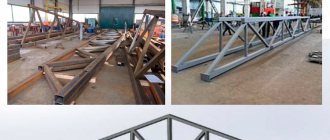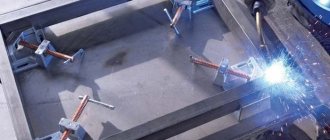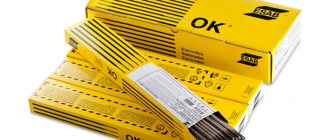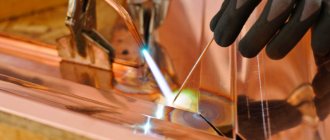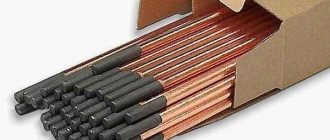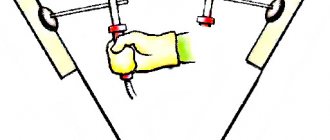The ability to read the electrode markings will help a novice welder choose the right consumables. This skill is necessary for suppliers to select goods purchased for production. The quality of the seam and the cost of the product depend on the correct choice. Let's consider what each letter or number in the marking means, what types of electrodes are available and other details that will be useful in the selection.
- Types of electrodes
- Electrode brands
- Electrode diameter
- Purpose of electrodes
- Coating thickness coefficient
- Index group
- Coverage type
- Spatial position
- Welding current characteristics
Where to find the markings
Marking is necessary to indicate the properties and characteristics of the metal rod and its coating, which affect the arc burning process and the formation of the welding joint. The electrodes themselves are produced in accordance with GOST 9466-75 and GOST 9467-75 and are necessarily marked so that the user can look at the designation and understand how best to use welding materials.
Labeling must be applied to the packaging. The inscription is placed on a white or blue field, free from the decorative design of the pack. Markings are also applied to the melting coating, closer to the end of the electrode inserted into the holder. Some manufacturers additionally indicate data on the side of the pack, but this is not a requirement.
Rutile coated electrodes
Rutile electrodes contain the highest percentage of natural titanium dioxide (rutile concentrate) in the coating composition. The weld seam obtained using rutile electrodes has less cracking, and its characteristics correspond to semi-quiet and calm steels.
Compared to other electrodes, rutile electrodes have many more advantages. First of all, these include easy slag separation and stable maintenance of the welding arc. When welding with rutile-coated electrodes, the metal spatters less, and the electrodes themselves are not so susceptible to moisture. They cook consistently even on poorly prepared, rusty metals.
Types of electrodes
E42A
-UONI-13/45-3.0-UD ———————————— E432(5)-B 1 0
The marking consists of a group of letters and numbers, behind which there are certain characteristics. For clarity of explanation, let’s take as an example common electrodes with the following markings:
The first indices E42A indicate the type of consumable element. There are several of them and they explain to the welder which metal is best welded with certain electrodes.
| Surfacing of the surface layer of metal | E-10, E-10G3, E-12G4, E-15G5, E-16G2ХМ, E-30G2ХМ - in total there are 38 types of this group |
| Welding structural carbon and low alloy steel | E38, E42, E46, E50, E55, E60 |
| Welding of carbon and low-alloy steels with increased requirements for impact strength and weld ductility | E42A, E46A, E50A |
| Welding of alloy structural steels | E70, E85, E100, E125, E150 |
| Welding of high-alloy structural steels | E-12X13, E-06X13N, E-10X17T, E-12X11NMF, E-12X11NVMF |
| Welding heat resistant steel | E-09M, E-09MH, E-09X1M, E-05X2M, E-09X2M1, E-09X1MF, E-10X1MNBF, E-10X3M1BF, E10X5MF |
In our example, type E42A is indicated, where:
- E - electrodes for RDS.
- The number 42 is the tensile strength, measured in kg per mm?.
- A - the weld metal will have increased ductility and impact strength.
Thanks to knowledge of this part of the marking, you can easily select electrodes based on the strength of the seam - the higher the number, the stronger the connection. For example, in our case, 42 means that the welded seam will withstand a load of 42 kg per 1 square millimeter. When resistance to sudden loads is required, choose consumables with the prefix “A” in the type.
Electrode markings - everything you need to know
When welding metals, their compatibility with the composition of the welded rods is determined by the marking of the electrodes, which is necessarily applied to the packaging.
The more accurately the materials are selected according to the elements, the stronger the connection will be.
It is important to be able to correctly read the information encrypted in alphanumeric notations, which contains information about the purpose and chemical composition of the electrodes and their coating.
How is the type indicated in the labeling?
The first few license plates and letters that are located on the electrode label carry information about the type of rod. In the example that you can see above, the encryption is E-50-A.
It is worth knowing that an electrode with such rods will be good for low-alloy or alloyed strong steel. The coding of electrodes for welding contains the following designations.
- Sign e. This sign on the electrode indicates the arc type of welding. The license plate, in our example, is the number 50. This is the shutter speed limit, and if it is written, for example, “50 kGs per square millimeter.”
- The letter sign A. It conveys information that the connection is flexible and has high impact strength. I think all these designations are very easy and you can simply remember them and keep them in your head. You can just write it down in a notebook and read it several times, and everything will be easy to remember, every letter and license plate.
Next, we will translate our article to other types of electrodes. We hope you will be able to remember the following signs without any problems; if you do not have a strong memory, then just write it down in a notebook. These cheat sheets will help you in the next steps.
Let's get started, in order to weld steel with low-alloy and carbon characteristics, you will need electrodes with rods E-38, E-150, E-42, E-100, E-46, E-85, E-50, E-70, E-42A, E-60, E-46A, E-55, E-50.
Remember that the letter sign E contains information about the tensile strength; if the steel is very strong, then the value of this letter should be large.
When you have to work with steel that is resistant to temperatures, you should use such electrodes. E-10-Kh-5MF, E09-M, E10-KhZ-M1 - BF, E09MH, E09-Kh1MF, E05Kh2M.
And if you have to work with low-alloy metals, which have some special features about working with them, you are offered a lot of varieties of electrodes, of course there are those that have gained the greatest popularity, such as: E12X13, E12X11NVMF, E06X13N, E12X11NMF.
If you need to make another ball on top, you need to be careful, because such a connection has some nuances, so it is recommended to use electrodes E30G2ХМ, E10G2, E16G2ХМ, E12G4, E12G4, E15G5, and these are only the most popular electrodes, and besides them there are more than forty species.
We were able to understand the types, but this is only a small part of what we need to know; there are still a lot of signs for separating and classifying electrodes according to a large number of features.
What parameters are encrypted in the marking?
The set of numbers and letters that can be seen on the package with rods encrypts all the information about their parameters and purpose. Here are the characteristics indicated on the label:
- type - designation of the tensile strength value (E46, E50, E60, etc.)
- brand - short name of the manufacturer;
- diameter - designation of the diameter of the rod;
- purpose - type of work for which electrodes can be used;
- coating thickness - designation of coating (there are 4 types);
- index - metal parameters (several parameters are shown here - impact strength, thickness, etc.);
- coating - designation of the type of coating applied to the electrode core (rutile, acidic, cellulose, basic);
- position - in what positions the electrodes can be used;
- welding current - current values required for work;
In addition to the above parameters, other characteristics may be included in the marking. For example, the packaging may indicate that the product is fragile or should be protected from dampness.
To make it easier to understand, let's look at the parameters and their designation using an example.
By brand
The next set of letters and numbers is the brand of the electrode (do not confuse it with the concept of marking). The brand can be established by GOST or patented by the manufacturer (as is the case with ESAB electrodes and their “OK” brand). In this case, several brands can correspond to the rod at once. This is a broad topic, so we have dedicated a separate article to it.
Electrode brand
Each type of electrode may correspond to one or more brands.
Electrode diameter
The diameter of the electrode (mm) corresponds to the diameter of the metal rod.
Determining product properties by code
For better memorization, you should clearly decipher the electrodes by designation. For example, you can take a product with the following code:
E46-LEZMR-3S-Ø-UD
E 43 1 (3)-RTs13
Layout for establishing properties by marking:
- electrode type E - well-known symbol, 46 - breaking load of the welded seam, kg/mm2;
- brand: LEZ - Losinoostrovsky Electrode Plant, MR-3S - in fact, this is the brand of the product established by the manufacturer;
- the diameter is indicated by a number or Ø symbol, which indicates the presence of a plate with dimensions or an inscription in the seal;
- purpose of the electrode and the power of its coating: U - weld carbon and low-alloy steel; D - thick coating;
- index E 43 1 (3) indicates the characteristics of the processed metals, the value is determined according to GOST 9467−75;
- type of coating - P (rutile), C - cellulose;
- position of the electrode during welding - 1, which means any; 3 - recommended welding current, it can be found in the table.
Today there is a large selection of products for connecting any metals using an electric arc. Using the markings, you can always choose exactly the electrode you need.
Types of rods for manual welding
Electrodes for arc welding are divided into consumable and non-combustible. The first ones are made of steel, cast iron, copper - depending on the metals being connected, and are used as a cathode or anode, a filler material.
The consumable electrode consists of an inner rod, the structure of which is determined by the properties of the metals being welded, and an outer shell.
The electrode coating (there are types without it) is multifunctional: holding the arc, adding the necessary chemical elements to the alloy for deoxidation and alloying of the metal, forming a gas cloud that protects the seam from oxidation.
Fireproof electrodes are made from refractory substances - coal, graphite or tungsten. With their help, the arc is ignited and held, and the weld is filled with metal by manually feeding fusible material into the heating zone.
The multitude of design options for coated electrodes in various combinations of substances that interact during welding has led to the emergence of several classifications that help guide the selection of the desired compositions. By purpose they are distinguished:
- carbon alloys with a small amount of impurities;
- surfacing electrodes with special properties;
- high strength steel;
- material with an expanded set of ligatures.
Other parameters indicate division: according to the thickness of the coating layer (thin, medium and thick), the type of current (direct and alternating), the composition of the coating (acid, basic, rutile) and the spatial location of the electrode. The cross-section of the rod and the quality of the seam also have their own coding.
Compound
The structure of the electrode is a rod coated with a special compound. The rod is made of a special welding wire, which melts during operation and forms a welding seam.
The process occurs under the influence of electric current. Melting of the coating occurs with the release of gas, which closes the welding zone from the penetration of oxygen.
When the coating melts, it forms a thin film that protects the weld seam from the appearance of oxides.
Figure 8 — Electrode composition
Electrode brands
E42A- UONI-13/45
-3.0-UD ———————————— E432(5)-B 1 0
The brand is determined by GOST or patented separately by the manufacturer if its designation differs from generally accepted standards. Indicates the purpose of the consumables. Among the standard brands according to GOST there are the following:
- ANO-4, -6, -17, -21, -24, -36, -37, -27, UONI 13/45, 13/55, MR-3, -5, TMU-21U, VN-48 - for welding low-alloy and carbon steels.
- OZL-6, -8, -17U, -9A, -25B, ZIO-8, ANZHR-3U, -13, NII-48G - for welding high-alloy steel.
- TsCh-4, MNCh-2 - for welding cast iron.
- T-590, -620, -6L, -12M, EN-60M, OZN-400 - for surfacing the surface layer.
- TsM-7S, OK-46, ANO-1, OZS-3, OZS-12 - for underwater welding.
Some manufacturers have created their own brands of electrodes for all these processes and patented the designations. The most common is OK from ESAB.
An example of how to decipher a marking
In order not to forget anything, let’s go through the markings again using the example of ANO21
- Type of electrode (E-46, this type is used when welding low-alloy steel, which does not have a high strength limit.
- The brand itself, as previously written by ANO21
- The diameter is 2.5 millimeters
- Where it can be used, the letter U indicates that it can be used for carbon or low-alloy steel.
Of course, the decoding is not finished - this will be your homework. Take a notepad and write everything down, take your time step by step and check everything well.
Of course, at first decoding the markings may seem complicated and incomprehensible, but this is not so, you just need to practice a couple of times and you will already be well oriented. Take a lot of different packs and practice on them by writing them down in a notebook.
Electrode diameter
E42A-UONI-13/45-3.0
-UD ———————————— E432(5)-B 1 0
The next thing in the marking is the diameter of the metal rod. The value is indicated in millimeters with tenths, separated by commas. The electrode cross-section is selected based on the thickness of the workpieces being welded and the welding current. Electrodes that are too thin will quickly burn and spatter the filler metal, while electrodes that are too thick will create additional resistance and make the welding poor due to the shallow penetration depth.
Storage rules
Have you ever used a welding machine?
It happened! It didn’t happen
The main problem encountered during storage is high air humidity. The electrode coating quickly absorbs moisture, making it impossible to work with such filler material. The only way to correct the situation is to calcinate the welding electrodes.
For this, there are special ovens or portable canisters with heating elements. At home, it is recommended to store packages open (without polyethylene) at a temperature of 20-22 degrees, relative humidity 40-50%.
Wet electrodes can cause pores to appear on the surface and inside the seam, and an increase in metal spattering will also be observed.
To correctly select welding electrodes, you need to have a good understanding of what alloy you need to work with.
You should also carefully prepare the additive itself and the surfaces to be welded for the operation:
- Remove dirt and rust.
- Heat the electrodes.
- Set the welding current correctly.
If the technology is followed, you can count on obtaining seams with the characteristics specified by the electrode manufacturer.
Purpose of electrodes
E42A-UONI-13/45-3.0- U
D ———————————— E432(5)-B 1 0
This is another element that indicates the suitability of certain metals and alloys for welding, as is the case with the type of electrodes:
- B - welding of high-alloy steels.
- T - welding of heat-resistant alloys.
- L - welding of structural steels containing alloying elements.
- N - used only for surfacing.
- U - welding of low-alloy and carbon steels.
Explanation of the designations of the electrodes used for welding.
The markings on the electrode pack are very important. This determines whether the selected welding materials are suitable. Let's look at the decoding of the notation. Designations are applied in accordance with GOST 9466. The marking has the form of a simple fraction, with a numerator and denominator.
E50A - This is a type of electrodes used for manual arc welding. It is determined depending on the material that needs to be boiled. For ordinary ferrous, heat-resistant and structural steels, the type is taken from GOST 9467. The number in the index that follows “E” indicates the temporary resistance ( σпч ). For a weld seam welded with E50 type electrodes, the temporary resistance is 50 kgf/mm2 . Next comes the stamp - “UONII 13/55” . The brand carries information about the metal from which the electrode core is made. The brand is selected based on the metal being welded. You can familiarize yourself with the list of main brands and their areas of application.
Let's go back to the labeling. After the mark comes the diameter of the electrode, indicated in millimeters - “4.0”. After the diameter comes the letter “U” - this place indicates the purpose of the selected electrodes.
Coating thickness coefficient
E42A-UONI-13/45-3.0-U D
———————————— E432(5)-B 1 0
Coating is necessary to protect the liquid metal of the weld pool from interaction with the external environment. The coating melts as the arc burns and the rod melts. The thicker the coating, the more protective gas is released. The coating thickness level is indicated in the electrode marking with the letter:
- M - thin.
- C - average.
- G - very thick (maximum possible).
- D - thick.
Advantages
If you compare DC electrodes with universal consumables, you can find many advantages:
- Large range of different diameters.
- Availability of various types of coatings to choose from.
- Low requirements for the professionalism of the welder.
- Possibility of welding without using flux.
- Low degree of metal spattering, leading to savings in electrode consumption.
- High work productivity.
- Arc stability.
- Ability to work outdoors.
- Getting a neat seam.
- Ability to weld parts of different thicknesses.
- No lack of penetration in the seam.
- Work in various positions.
- Reliability and durability of the resulting connection.
Such advantages are inherent in most types of consumables of this kind.
Index group
Sometimes the marking contains an additional designation written under the horizontal line.
E42A-UONI-13/45-3.0-UD ———————————— E432(5)
-B 1 0
Digit 4
indicates the resistance of the weld to corrosion. There are five levels in total (0/2/3/4/5) - the higher the number, the better. In our example, the number is 4, which indicates high protection of the seam from rust during subsequent use.
Digit 3
refers to the maximum temperature at which the heat resistance of a joint is maintained. There are 9 options in total, where 1 is 500 degrees, and 9 is over 850 degrees. In our case 3 - the seam will withstand heating up to 560-600? With no loss of properties.
Digit 2
— limit of working temperature of the seam. It also has 9 levels with an indicator from 600 to 1100 degrees. In our example, 2 indicates a limit of 650? C, after which changes will begin in the metal.
The value taken in brackets (5) is the amount of ferrite phase in the weld. The index is divided into 8 levels with percentages from 0.5-4.0% to 10-20%. With our indicator 5, the content of the ferrite phase ranges from 2.0 to 8.0%.
Such a group of indices does not indicate several characteristics at once. Usually, it is written on the packaging of electrodes intended for working with low-alloy and alloyed metals.
Properties
Electrodes for permanent use do not have any special differences in appearance from conventional consumables, but their features begin to actively manifest themselves during operation. The quality of their manufacture is especially important, so it is recommended to use electrodes from trusted brands in this area.
DC electrodes must be manufactured in accordance with existing regulatory materials and GOSTs. Deviations from their requirements during manufacturing and testing can lead to poor-quality seams and even damage to the surface of the processed products. You should begin the welding process only after making sure that the quality of the electrodes corresponds to the accuracy category required to perform a specific job.
The characteristics of these types of electrodes are indicated on their labeling. The brand of equipment used does not affect this.
Coverage type
E42A-UONI-13/45-3.0-UD ———————————— E
432(5)-
B
1 0
The letter E at the beginning of the second line of marking indicates a consumable electrode, the coating of which burns out from the temperature of the electric arc. But the type of coating is indicated by the letter B. There are four main options, as well as their mixing with each other:
- A - this is the designation for acidic coating. Electrodes with this marking are manufactured for work in all spatial positions on direct and alternating current. But they cook poorly from top to bottom. Not suitable for joining metals with a high carbon and sulfur content; they promote splashing of droplets and may cause cracks in the seam.
- B is the main coating designed for welding with direct current of reverse polarity. Suitable for joining thick workpieces.
- P - designation for rutile coating. Electrodes can work on alternating or direct current in any spatial position, but verticals from top to bottom are difficult.
- C - cellulose coating. Consumables are used for the installation of metal structures; they are excellent for welding in all positions in space on direct and alternating current. But there are increased losses due to splashing.
- RB, AC - mixed coating options. Optimal for welding in the lower and vertical positions of pipelines. Provide low consumption.
In order for the electrode to correspond to the markings, its coating must contain chemicals in certain proportions. These can be: quartz sand, kaolin, marble, manganese ore, titanium concentrate, chalk, etc. It is the gas from the molten coating that reacts with the weld pool and gives the seam certain characteristics. This process occurs during the burning of the arc and after its extinction, while a new crystal lattice is formed.
Electrodes with basic coating
The basis of this coating is fluoride compounds. In terms of its chemical composition, the metal deposited with electrodes with a basic coating is very close to mild steel. The welding seam is characterized by high levels of impact strength, strength and ductility, due to the low content of electrodes, non-metallic inclusions, gases, and also harmful impurities in the coating composition.
Electrodes with a basic coating are somewhat inferior to other electrodes in terms of sensitivity when welding rusty metals. Also, during the welding process, pores often form on the seams. Electrodes with a base coating are quite sensitive to moisture, so they quickly become damp, requiring calcination before use.
Spatial position
Indicates for which positions in space the electrodes are intended. Ignoring this part of the marking leads to poor weld penetration, burn-throughs, and increased metal consumption due to splashing and dripping. There are four index options in total:
E42A-UONI-13/45-3.0-UD ———————————— E432(5)-B 1
0
- universal for all positions (as in our example).
- for all positions except vertical top-down.
- optimally cooked horizontally on a vertical surface. Not intended for ceiling welding.
- for bottom corner, tee and regular connections.
Features of DC welding
The welding process using constant voltage has a number of distinctive properties. Some characteristics can be considered as advantages, others as disadvantages.
Pros:
- the almost complete absence spattering ensures a reduction in electrode costs;
- the constant makes the welder’s work easier ;
- high productivity and labor efficiency;
- stability and stability of the arc even when exposed to negative influences: gusts of wind, voltage fluctuations and others;
- high-quality and neat seam;
- thin products ;
- absence of uncooked areas.
Minuses:
- welding using direct current is carried out using inverter machines. This equipment is highly expensive ;
- “magnetic blast” creates problems with an unstable arc in difficult places (eg corners).
Forward or reverse polarity
A welder needs to know! Connecting metals with direct current can be carried out in two modes: with direct and reverse polarity. First mode: a minus is connected to the electrode, and a plus to the metal product. When welding, reverse polarity is the opposite: positive to the electrode , negative to the workpiece.
Welding with direct polarity forms a cathode spot at the tip of the electrode, and reverse polarity creates an anodic spot. In the area of the anode spot the temperature reaches 3900°C, in the area of the cathode spot – up to 3200°C. During reverse polarity welding, heat is concentrated on the workpiece , causing the root of the weld to deepen .
Therefore, it is better to use reverse polarity voltage when welding thick-walled products and in cases where high temperatures are required .
Direct polarity current is used to work with the following materials:
- structures made of thin sheet steel;
- fusible metals;
- overheat-sensitive steels : stainless, alloyed and high-carbon.
Features of welding with reverse polarity:
- large spattering and high penetration are due to the fact that the metal from the materials is transferred into the weld pool in large drops;
- the electric arc is unstable ;
- correct heating of the product;
- some welding consumables show an increase in deposition rate ;
- the weld seam has a non-standard material composition : no carbon, a large amount of silicon and manganese.
- less heating of the rod allows the specialist to use currents with a higher value .
Features of connection with reverse polarity:
- the need to reduce the current potential to reduce the temperature of the product;
- It is recommended to weld with intermittent seam;
- very thin parts are welded with periodic interruption of the arc;
Flanging (see features of welding thin metal) - When joining with an overlap, the workpieces must be pressed tightly against each other. Failure to comply with this condition may result in burning of the upper part.
- the butt connection should be made with a minimum gap or, best of all, no gap at all;
- When welding thin products with uneven edges, a copper or steel plate should be placed under the joint . Such an auxiliary layer will take away some of the heat from the welding process;
- it is possible to flange the edges to be joined, the angle is 90°.
Useful video
Watch the video, which clearly explains the difference in the use of polarities.
[ads-pc-2][ads-mob-2]
